Exploring Liver Cirrhosis Treatment Options
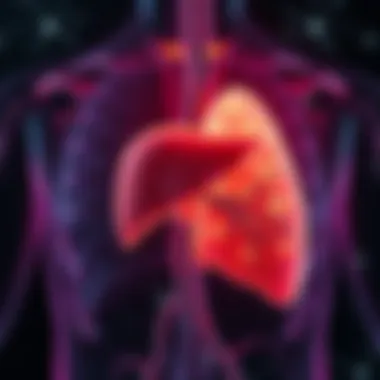
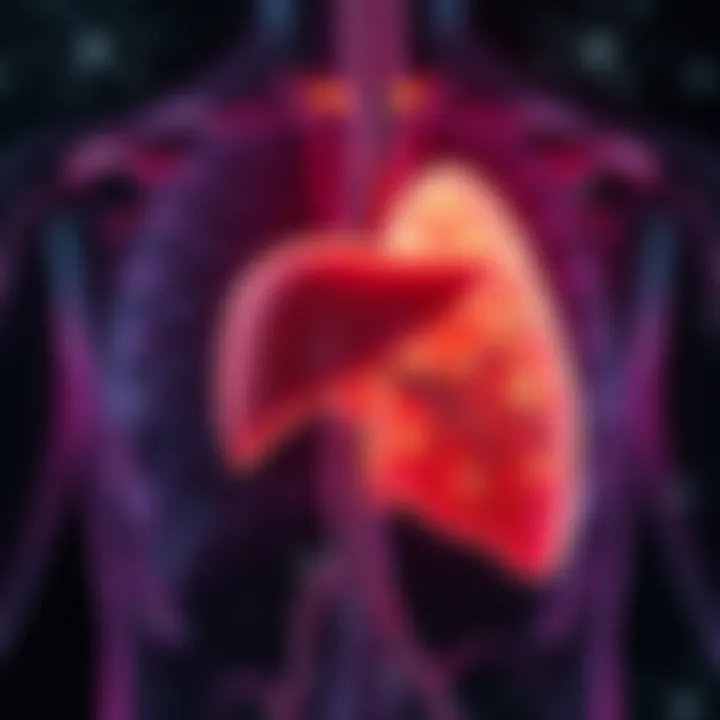
Overview of Research Topic
Brief Background and Context
Liver cirrhosis is a chronic condition characterized by the progressive replacement of healthy liver tissue with scar tissue, significantly impairing liver function. This condition can stem from several factors, including excessive alcohol consumption, viral hepatitis, and non-alcoholic fatty liver disease, leading to a host of complications if left untreated. Understanding liver cirrhosis is crucial as it poses significant health risks and affects millions of people globally. Recognizing the underlying causes and manifestations of this disease aids not only in diagnosis but also in tailoring appropriate treatment options.
Importance in Current Scientific Landscape
The significance of studying liver cirrhosis treatment options cannot be overstated. With the prevalence of liver diseases rising, the need for a well-rounded comprehension of effective therapies becomes increasingly important. Early diagnosis and prompt intervention can substantially enhance patient outcomes. Moreover, recent advancements in research have uncovered emerging therapies and lifestyle changes that can significantly improve the quality of life for those managing cirrhosis. In an era where personalized medicine is gaining traction, understanding the multifaceted approaches to treating this disease is vital for healthcare professionals, researchers, and patients alike.
Treatment Options for Liver Cirrhosis
Pharmacological Interventions
The treatment landscape for liver cirrhosis is diverse, including both established and innovative medication therapies. Current pharmacologic options focus on addressing symptoms and managing complications rather than curing the condition entirely. Some commonly prescribed medications include antiviral drugs for viral hepatitis and diuretics to manage fluid retention. Newer therapies like elafibranor are currently under investigation and show promise in mitigating fibrosis progression.
Lifestyle Modifications
Beneath the pharmacological interventions, lifestyle changes play an essential role in slowing the disease's progression. Recommendations often include:
- Abstaining from alcohol
- Adopting a balanced diet rich in proteins and vitamins
- Regular physical activity tailored to the patient's capabilities
These modifications can serve to bolster liver health and improve overall well-being, emphasizing the incorporation of healthy habits into daily routines.
Nutritional Support
Proper nutrition is vital in managing liver cirrhosis. A specialist may recommend individualized dietary plans to prevent malnutrition, a common issue among patients. These plans often focus on
- High-protein foods
- Reduced salt intake to manage fluid accumulation
- Adequate hydration
Nutritional education ensures that patients make informed choices that support liver function.
"Managing liver cirrhosis is not just about medication; it’s about a holistic approach that bridges pharmacological and lifestyle strategies."
Multidisciplinary Care
The complexity of liver cirrhosis necessitates a multidisciplinary approach in patient management. A team consisting of hepatologists, nutritionists, and mental health professionals can provide comprehensive care tailored to the needs of each patient. This collaboration enhances treatment effectiveness and encourages continuous monitoring of the disease’s progression, ensuring that patients receive the most appropriate interventions.
Future Directions
Research in liver cirrhosis treatment is progressing swiftly, with ongoing clinical trials exploring novel therapies and management strategies. Investigations into gene therapy and stem cell treatments hold promise for breaking new ground in treatment efficacy and patient outcomes. As we journey forward, the combined efforts of researchers and healthcare providers will be critical in developing effective treatment protocols.
Finale
The treatment of liver cirrhosis requires a careful balance of conventional and novel approaches. Focused on patient-centered care and scientific advancements, the future looks hopeful for those grappling with this complex condition. As the scientific community continues to delve deeper into innovative therapies and supportive care measures, the aim remains clear: promoting liver health and improving patient quality of life.
For more information on liver cirrhosis and its treatment options, visit reputable resources such as
- Mayo Clinic
- American Liver Foundation
- National Institute of Diabetes and Digestive and Kidney Diseases
- World Health Organization
Understanding liver cirrhosis and its treatment landscape is imperative not only for medical professionals but also for those personally affected by this condition. With ongoing research, there is hope for better management strategies that can significantly improve quality of life.
Understanding Liver Cirrhosis
Liver cirrhosis represents a significant health issue that emerges when the liver sustains gradual, permanent damage. A clear comprehension of this ailment is essential not only for patients but also for healthcare professionals involved in the management and treatment processes. Understanding liver cirrhosis encompasses several vital elements that explicitly delve into the condition's etiology, progress, and subsequent implications for treatment.
Recognizing the importance of understanding liver cirrhosis serves several critical purposes. First, gaining insights into this condition allows individuals to identify it early, enabling timely intervention. Early diagnosis can potentially reverse damage or slow disease progression. Furthermore, knowledge of liver cirrhosis equips patients to make informed choices regarding their lifestyle and treatment options, which in turn can significantly improve their quality of life and long-term prognosis.
Moreover, an awareness about the stages of liver cirrhosis helps in tailoring treatment strategies. Understanding the distinct characteristics of compensated versus decompensated cirrhosis can guide medical practitioners in determining the most suitable interventions. Raw knowledge about the etiology can spur research, pressing the need for further studies into effective therapies.
Ultimately, understanding liver cirrhosis presents both a challenge and an opportunity. While it poses significant health risks, a deeper comprehension can facilitate better management and improve patient outcomes. This article will explore various facets of liver cirrhosis, fostering a broader awareness among readers of this multifaceted issue.
Clinical Presentation and Diagnosis
Understanding the clinical presentation and diagnosis of liver cirrhosis is pivotal in managing the disease effectively. Early recognition of symptoms can lead to timely interventions, ultimately impacting the quality of life and survival rates of patients. This section will delve into the signs and symptoms, as well as the diagnostic techniques employed to identify liver cirrhosis.
Signs and Symptoms
Jaundice and Skin Changes
Jaundice is a hallmark sign of liver cirrhosis, characterized by a yellowing of the skin and the whites of the eyes. This occurs due to the accumulation of bilirubin, a byproduct of red blood cell breakdown, as the liver struggles to process it efficiently. The key characteristic of jaundice lies in its visibility; it's often one of the first indicators of liver dysfunction that patients or their families may notice.
This condition serves as a beneficial choice for practitioners in the clinical setting because it prompts further investigation into liver health. The unique feature of jaundice is that it can also present with accompanying skin changes, such as itching and dark urination, which can provide additional context for diagnosing the underlying cause of the liver impairment. However, it is important to consider that while a clear indicator, jaundice itself doesn't pinpoint the specific type or stage of liver disease, thus necessitating further diagnostic measures.
Ascites and Fluid Retention
Ascites, the accumulation of fluid in the abdominal cavity, is another common feature of liver cirrhosis. This condition can be uncomfortable and lead to significant abdominal swelling. The key characteristic of ascites is its correlation with increased pressure in the liver’s blood vessels due to scarring. This is a popular point of focus for clinicians, as it presents a physical manifestation of the underlying complications of cirrhosis.
Ascites allows for the assessment and management of liver cirrhosis from a symptomatic perspective. The unique aspect of this condition is that it's not merely a cosmetic issue; it can severely affect a patient’s mobility and overall comfort. While treating ascites can alleviate discomfort, it can pose challenges as fluid management requires careful monitoring and, at times, invasive procedures, such as paracentesis.
Fatigue and Weakness
Fatigue and weakness are often reported by patients suffering from liver cirrhosis. They signify the body's reduced ability to perform daily tasks and can contribute significantly to a decreased quality of life. A key characteristic of this symptom is its pervasive nature; it can impact mental health and the ability to engage socially or professionally.
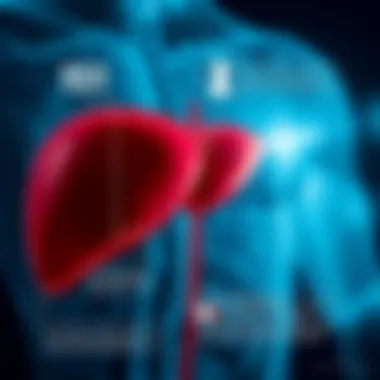
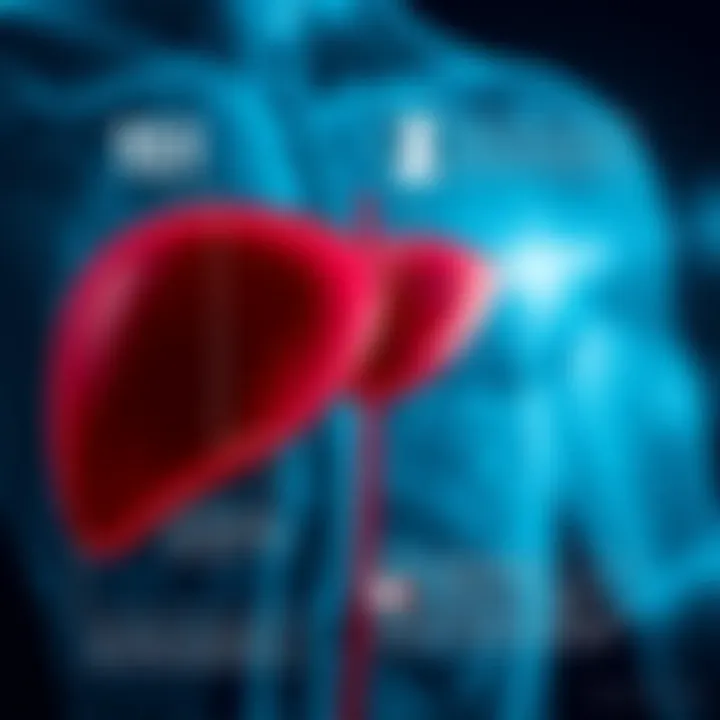
This is a crucial consideration for patients and healthcare providers. The unique feature here is that fatigue may not directly correlate with the severity of liver disease, as patients with milder forms can experience debilitating tiredness just as those in advanced stages. Addressing fatigue often involves a multifaceted approach, including lifestyle modifications, dietary support, and sometimes pharmacological interventions, making it a critical aspect of cirrhosis management.
Diagnostic Techniques
Liver Function Tests
Liver function tests (LFTs) are essential in assessing the state of the liver and are a fundamental diagnostic tool when cirrhosis is suspected. These tests measure various enzymes, proteins, and substances produced or processed by the liver. The key characteristic of LFTs is their ability to provide quick insights into liver function and potential damage.
LFTs are a beneficial addition to the diagnostic arsenal for cirrhosis as they can signal dysfunction even before symptoms are evident. A unique advantage of these tests is their non-invasive nature and ease of access, as they require only a simple blood sample. However, one limitation is that abnormal LFTs do not always indicate cirrhosis specifically, as other liver conditions can also produce similar results.
Imaging Studies
Imaging studies, such as ultrasound, CT scans, and MRI, play an important role in diagnosing liver cirrhosis. These techniques help visualize the liver’s structure and any possible complications, such as ascites or tumors. The key characteristic of imaging studies is their capacity to provide clear visual evidence of liver condition.
From a diagnostic perspective, imaging studies can reveal structural abnormalities, such as nodularity and size changes, which can suggest cirrhosis. Their unique feature lies in their ability to guide clinicians on the next steps for patient care. However, one disadvantage includes the potential for misinterpretation of results due to overlapping features with other liver diseases.
Liver Biopsy
Liver biopsy remains a definitive method for diagnosing liver cirrhosis. In this procedure, a small sample of liver tissue is removed and examined microscopically. The key character of a biopsy is its precision; it directly assesses the degree of scarring and any cellular changes.
This diagnostic option is beneficial as it provides conclusive evidence on the severity of liver damage and helps in determining the underlying cause. A unique aspect of liver biopsy is its ability to distinguish between various types of liver diseases. However, it's important to weigh this against the risks associated with biopsy procedures, such as bleeding or infection, making it a choice that's typically reserved for unclear cases or when more detailed information is necessary.
Effective diagnosis is the linchpin in the management of liver cirrhosis, providing a roadmap for intervention strategies tailored to individual patient needs.
Pharmacological Interventions
When navigating the convoluted landscape of liver cirrhosis, pharmacological interventions play a pivotal role. Their importance cannot be understated; these medications are not just pills to swallow. They aim to manage symptoms, slow disease progression, and enhance overall health, which are critical for patients facing this formidable condition.
Effective treatment often hinges on a combination of established medications and new therapeutic avenues. Here’s a closer look at the current medications and emerging therapies.
Current Medications for Liver Cirrhosis
Diuretics for Fluid Management
Diuretics hold a key position in managing fluid retention—a common and distressing symptom of liver cirrhosis. This retention can lead to significant discomfort and more severe conditions, such as ascites. These medications facilitate fluid excretion through the kidneys, thereby relieving the burden on the body.
A primary characteristic that makes diuretics popular is their ability to provide rapid relief. Patients often find immediate alleviation from abdominal swelling, which enhances their quality of life.
However, one of the notable downsides is the potential for electrolyte imbalances, particularly potassium depletion. To navigate this, healthcare providers might monitor serum electrolytes closely while adjusting the treatment plan as needed.
Lactulose for Hepatic Encephalopathy
Lactulose is valuable in treating hepatic encephalopathy, a condition that arises from liver failure, which affects brain function. By decreasing ammonia levels in the blood, lactulose helps prevent cognitive deterioration and confusion. This medication is key because it not only serves to stabilize brain function but can also improve overall liver function.
Its unique mechanism of action, which involves conversion to lactic acid within the colon, benefits the patient by promoting bowel movements. Yet, challenges arise due to potential gastrointestinal side effects like bloating or diarrhea, which can be uncomfortable for the patient.
Antivirals in Viral Hepatitis
Antivirals, particularly in cases of viral hepatitis leading to cirrhosis, have become fundamental in treatment. Their role is essential to reducing viral loads, which directly contributes to slowing the progression of liver damage. This is crucial for patients where viral infections are contributing factors to their cirrhosis.
The advantage of antiviral therapy lies in its targeted action against specific viral pathogens. However, these medications can also present a range of side effects, from mild to severe, which need consideration when weighing treatment benefits against risks. Monitoring for resistance or adverse reactions is an essential part of incorporating this treatment into patient care.
Emerging Therapies and Research
New Antifibrotic Agents
Amidst ongoing research, new antifibrotic agents show promise in tackling fibrosis, a hallmark of liver cirrhosis. These agents aim to halt or even reverse the fibrotic process that underlines much of cirrhosis pathology. They do not merely treat symptoms but target the underlying mechanisms of liver scarring.
The appeal of these agents lies in their specificity. They can potentially minimize harm to healthy liver tissue while directly addressing the fibrosis. However, their long-term effects and safety profiles are still under assessment, necessitating thorough research.
Gene Therapy Approaches
Gene therapy introduces a transformative potential in liver cirrhosis management. By targeting the genetic roots of liver diseases, these therapies offer a radical shift from traditional methods. Their distinct characteristic lies in their ability to correct or modify defective genes that contribute to disease.
Nonetheless, the novelty of gene therapy comes with its own set of challenges—regulatory hurdles, ethical considerations, and the need for advanced delivery systems mean that it’s still in the experimental phase. As trials progress, the potential benefits could redefine treatment paradigms in liver health.
"Advancements in pharmacological interventions illustrate a commitment to improving patient outcomes and emphasizing a multifaceted approach to liver cirrhosis."
Understanding these pharmacological strategies, while being mindful of their strengths and limitations, equips both patients and healthcare providers with the knowledge needed to navigate the complexities of liver cirrhosis treatment. This journey through innovative treatments shows the promise of new frontiers in managing what once felt insurmountable.
Lifestyle Modifications
Lifestyle modifications play a pivotal role in the management of liver cirrhosis. These changes can directly impact the progression of the disease and improve overall health outcomes. By altering diet and increasing physical activity, patients can potentially reduce complications associated with cirrhosis and enhance their quality of life.


Dietary Changes
Low Sodium Intake
Low sodium intake is critical for individuals with liver cirrhosis. Excess sodium can exacerbate fluid retention, leading to ascites, a condition characterized by fluid accumulation in the abdomen. A diet low in sodium helps manage this issue, significantly reducing the discomfort associated with swelling. By avoiding highly processed foods – which often contain hidden salts – and focusing on fresh ingredients, patients can maintain healthier sodium levels.
One key characteristic of low sodium diets is that they foster a heightened awareness of food choices. Patients who actively monitor their sodium intake often become more educated about others aspects of nutrition as well. This can lead to better eating habits overall. However, one downside may be that adhering to a low sodium plan can be challenging in social situations where food options are limited. It's crucial for these individuals to plan meals ahead, ensuring they remain within sodium restrictions while enjoying their diet.
Balanced Nutritional Support
Balanced nutritional support is another cornerstone of managing liver cirrhosis. A diet rich in protein, vitamins, and minerals, while considering individualized needs, can aid in combating malnutrition, a common issue in liver disease patients. A key feature of this approach is flexibility. Patients are encouraged to customize their meals with various foods that fulfill nutritional needs without being overly restrictive.
That flexibility allows individuals to include proteins from both animal and plant sources, ensuring a well-rounded intake of essential nutrients. On the downside, navigating dietary choices can be overwhelming for some. However, when properly guided by a professional, this allows for a more palatable and acceptable dietary strategy for long-term adherence.
Exercise and Physical Activity
Importance of Regular Activity
Regular activity holds significant importance for those living with liver cirrhosis. Engaging in consistent physical activity helps maintain muscle mass and supports overall metabolic function. Staying active can also aid in managing any potential weight gain that may come from fluid retention or medication side effects.
A key characteristic of regular activity is its positive effect on mental health as well. Exercise can elevate mood and reduce stress, which are crucial components during the journey with a chronic illness like cirrhosis. On the other hand, not all patients may feel capable of engaging in strenuous exercise due to fatigue or other limitations stemming from their condition, so it's vital to tailor workouts alongside healthcare providers.
Tailored Exercise Programs
Tailored exercise programs are designed to fit each patient's unique limitations and abilities. These programs take into consideration the individual’s health status, preferences, and any existing physical restrictions. The goal is to create a sustainable routine that promotes overall wellbeing while avoiding excess strain on the liver.
A key characteristic of these programs is their adaptability. They can shift based on how the patient feels and their physical progress over time. For instance, someone may start with gentle stretching and gradually include more vigorous activities like walking or cycling. The downside is that patients may need assistance finding the right program, as generalized advice is not always suitable for those with specific health concerns. However, working with trained professionals usually addresses these difficulties, enhancing the success of the exercise regimen.
The crux of successful lifestyle modifications lies in understanding that small, consistent changes can yield significant benefits for liver health.
In summary, both dietary adjustments and increased physical activity offer powerful tools for managing liver cirrhosis. While challenges exist, the rewards often far outweigh the difficulties, leading to enhanced patient wellbeing and better health outcomes.
Multidisciplinary Care Approach
A multifaceted approach to the management of liver cirrhosis isn't just a good idea; it's practically essential in today's healthcare landscape. With the condition's complex nature, it requires the expertise of various professionals to tackle different facets. This collaborative effort is often referred to as multidisciplinary care, and it brings together a team of specialists who work in harmony to deliver all-round care and support for patients.
Role of the Healthcare Team
Gastroenterologists
Gastroenterologists play a vital role in managing liver cirrhosis. These specialists focus on the digestive system, particularly the liver, and they bring a depth of knowledge that is invaluable for both diagnosis and treatment. One of the key characteristics that set gastroenterologists apart is their proficiency in interpreting complex liver function tests and imaging studies.
Their unique feature lies in their ability to offer tailored treatment plans based on the patient's specific disease stage and underlying causes. This kind of precise and personalized care can substantially improve a patient’s outlook. However, while they are excellent at handling the clinical aspects, patients might require additional support for dietary or emotional issues.
Nutritional Experts
Nutrition is a cornerstone of managing liver health, and that's where nutritional experts come into play. These professionals understand how to tailor diets that help minimize symptoms like ascites or jaundice. They provide dietary guidelines that are low in sodium and high in essential nutrients, which can significantly enhance a patient's quality of life.
The main characteristic of nutritional experts is their ability to assess individual needs based on each patient's condition. Their unique approach can provide an edge in overall wellbeing but can also become a bit complex for patients who may not know how to implement these dietary changes effectively. They help mitigate risks related to malnutrition, but patients need to be fully onboard for the changes to stick.
Psychological Support
Living with a chronic condition like liver cirrhosis often takes a toll on mental health. That’s where psychological support comes in. Specialized therapists or counselors offer critical emotional support, helping patients deal with feelings of anxiety or depression that may arise due to their condition.
The essential feature of psychological support lies in its holistic approach, focusing not just on the physical aspects of cirrhosis but also on mental wellbeing. This support can significantly enhance treatment adherence and improve overall quality of life. However, one downside can include the stigma that sometimes comes with seeking psychological help, making it essential to create a safe and understanding environment for patients.
Patient Education and Support
Understanding the Condition
Understanding liver cirrhosis and its implications is crucial for effective disease management. When patients comprehend their condition in depth, they are better equipped to make informed decisions regarding treatments and lifestyle choices. This understanding fosters a sense of empowerment.
The significant characteristic here is the availability of educational resources, such as pamphlets and counseling sessions, which can demystify medical jargon. One unique aspect is the emphasis on not just learning about the illness but also recognizing the importance of self-care. However, material overload can sometimes lead to confusion, making it vital to present information clearly.
Resources for Care Management
Resources for care management play an integral role in helping patients navigate their treatment journey. These might include community support groups, online forums, and accessible educational platforms. Such resources empower individuals by connecting them with others who face similar challenges, creating a sense of community.
One key feature of these resources is their diversity; they can range from local support networks to websites that offer comprehensive care plans tailored to liver patients. While these platforms provide excellent access to information, the potential downside is the risk of misinformation. It's crucial for patients to discern quality information from unreliable sources.
By emphasizing a multidisciplinary approach, focusing on the strengths of each team member, and ensuring proper patient education and support, the management of liver cirrhosis can be markedly improved. Taking a holistic view is not just beneficial; it's becoming increasingly necessary in modern healthcare.
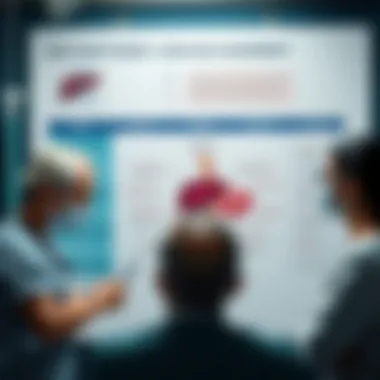

Living with Liver Cirrhosis
Living with liver cirrhosis is not merely about managing symptoms; it’s a holistic experience that requires attention to various aspects of life. Patients often find themselves navigating a complex landscape filled with medical, emotional, and lifestyle challenges. One of the most crucial elements in this journey is understanding how to manage the chronic illness effectively. This includes adhering to treatment plans and actively monitoring for potential complications, which can significantly influence the course of the disease and overall well-being.
Effective management of chronic illnesses is essential for maintaining health and minimizing the risks associated with liver cirrhosis. Furthermore, quality of life plays a pivotal role. This encompasses finding ways to maintain daily activities and establishing supportive networks, which can provide a sense of normalcy and community in the face of adversity. Therefore, addressing both the clinical and the psychosocial aspects of living with cirrhosis is key to improved outcomes.
Management of Chronic Illness
Adherence to Treatment Plans
Adherence to treatment plans stands as the backbone of effective liver cirrhosis management. Sticking to prescribed medications and recommended lifestyle changes can drastically improve a patient’s health outlook. Research shows that consistent adherence reduces hospitalizations and complications, which is a primary goal for both healthcare providers and patients alike.
The key characteristic of adhering to treatment is its ability to transform a complex, sometimes daunting regimen into manageable steps. Patients may think that taking their meds on time is not a big deal, but it can create a ripple effect; for instance, improved adherence leads to better liver function, which subsequently enhances energy levels and overall quality of life.
Unique features of adherence include not only the pharmacological aspects but also the recommendations for diet and regular follow-ups with healthcare professionals. However, one must be mindful that distractions or forgetfulness can interfere with adherence. Patients are encouraged to use tools like pill organizers or mobile health apps to keep track of their treatment plan.
Monitoring for Complications
Monitoring for complications is another vital component of living with liver cirrhosis. Keeping a keen eye on the condition can lead to early detection of potential health issues like variceal bleeding or hepatic encephalopathy. This timely intervention makes all the difference, potentially preserving liver function and preventing hospitalization.
The key characteristic here lies in the proactive approach. Being vigilant about symptoms—such as sudden swelling, confusion, or jaundice—can alert patients and healthcare providers to possible complications before they escalate.
One unique feature of effective monitoring is the use of self-assessment tools, which can help patients quantify their symptoms. On the flip side, it’s important to note that while some may find constant monitoring reassuring, others may feel overwhelmed by the persistent need for vigilance and the worry it brings.
Quality of Life Considerations
Maintaining Daily Activities
Maintaining daily activities, though seemingly straightforward, is essential in the life of someone living with liver cirrhosis. Engaging in routine tasks, whether it’s going to work, enjoying a hobby, or socializing with friends, contributes significantly to emotional resilience and overall well-being.
The key characteristic of maintaining these activities is the sense of normalcy it brings, which can be a powerful antidote to feelings of isolation or despair that often accompany chronic illness. Being involved in daily life fosters a sense of purpose, making the struggle with cirrhosis feel a little less daunting.
However, patients may face challenges, such as fatigue or dietary restrictions. To navigate this, many find creative adaptations helpful—like adjusting work hours or finding low-energy pastimes, which can make a world of difference in execution.
Supportive Networks
Supportive networks can be invaluable for individuals grappling with liver cirrhosis. These networks might comprise family, friends, health care professionals, or even support groups. They provide emotional reinforcement and practical assistance, helping patients shoulder the burden of their condition.
The key characteristic of having these networks is the profound feeling of understanding and validation it brings. Knowing one is not alone—having a community that understands the struggles and nuances of cirrhosis—creates a firm foundation for coping.
Additionally, unique features such as online forums or local liver disease support groups can facilitate connections among individuals with similar experiences. However, patients must choose their networks wisely; not every advice is good advice, and misinformation can sometimes lead to confusion or improper care decisions.
"A well-equipped support network is like having a lifeline in turbulent waters."
Future Directions in Liver Cirrhosis Management
Future directions in liver cirrhosis management represent a beacon of hope for many individuals affected by this complex disease. With the ongoing research and innovations, the horizon appears to be brightening. Understanding these future trends is paramount, as they promise significant advancements in treatment approaches, enabling a more personalized and effective management strategy.
Innovations in Treatment
Potential Clinical Trials
Potential clinical trials play an important role in the journey toward better liver cirrhosis management. They serve as a testbed for new therapies that may prove more effective than current treatments. These trials often focus on exploring novel therapeutic targets that could, for instance, halt or even reverse liver damage.
One of the standout features of these trials is their patient-centric approach. By prioritizing participant feedback and outcomes, they ensure that new treatments meet real-world needs. This is particularly beneficial for patients, who often face limited options. However, it’s essential to consider that clinical trials may not yet be widely available to all communities, creating disparities in access.
"Clinical trials are crucial for discovering innovative treatments for liver cirrhosis, often paving the way for medicines that significantly impact patient lives."
Advancements in Drug Development
Advancements in drug development have been extraordinarily promising in the context of liver cirrhosis. This facet of research focuses on designing targeted therapies that address the specific pathways involved in fibrosis and overall liver health. Such innovations might include novel antifibrotic agents that aim to reduce scar tissue in the liver.
A key characteristic of these advancements is their scientific rigor. Extensive preclinical studies and subsequent human trials ensure that these drugs are not only effective but also safe for consumption. This scientific groundwork is critical, as it helps to minimize potential adverse effects that might have arisen from less scrupulous formulations. However, despite this progress, the time taken from concept to market can significantly delay access for those in need.
Research Gaps and Needs
Understanding Disease Progression
A paramount aspect of future liver cirrhosis management lies in understanding disease progression. Delving into the biological mechanisms that drive cirrhosis informs researchers about potential intervention points. Knowing how the disease evolves can help tailor treatments to individual patient needs, thus improving outcomes.
This focus on disease progression is notably beneficial, as it encourages proactive management strategies rather than reactive ones. Consequently, healthcare providers can recommend more effective lifestyle changes and interventions. However, the intricacies of liver pathology can complicate these efforts, as there is still much to learn about varying patient responses.
Strategies for Prevention
Lastly, developing effective strategies for prevention remains a significant area of emphasis. This involves identifying high-risk populations and implementing early interventions to slow or halt disease progression before cirrhosis truly sets in. Education on lifestyle modifications, as well as screening protocols, must be built into public health frameworks.
The primary advantage of preventative strategies is their potential to reduce healthcare costs and improve life quality long before serious complications arise. Nevertheless, this proactive approach requires substantial investment in public health resources and education efforts, which may prove challenging in underfunded healthcare systems.
In summary, the future of liver cirrhosis management is laden with intriguing possibilities. Innovations in treatment methods, a thorough understanding of disease progression, and robust preventative strategies can truly reshape the landscape for patients facing this daunting challenge.



